
 |
An Overview of the 1997-98 |
We will be providing our complete analysis of the budget proposal and our own updated budget-related projections on February 19 in our Analysis and Perspectives and Issues publications.
| Figure 1 Total Proposed Budgetary Spending | ||||
| (Dollars in Billions) | ||||
| Actual
1995-96 |
Estimated 1996-97 |
Proposed 1997-98 | ||
| Amount | Percent
Change | |||
| General Fund | $45.4 | $48.4 | $50.3 | 3.8% |
| Special funds | 12.5 | 13.6 | 14.3 | 5.5 |
| Totals | $57.9 | $62.0 | $64.6 | 4.2% |
Types of Spending. Figure 2 shows how spending from the state's General Fund is distributed across major program areas. It indicates that over four-fifths of this spending is for education-related and health and social services purposes. The remainder is spent for criminal justice, resources, tax relief, and general government.
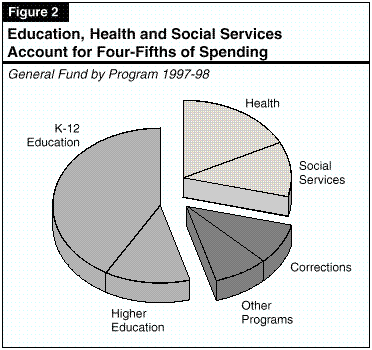
|
Figure 3 Key Features of the Governor's 1997-98 Budget Proposal | ||||
|
||||
|
||||
|
||||
|
||||
|
||||
|
|
|||
|
||||
|
||||
|
||||
Budget Is Balanced. As noted in Figure 3 and detailed in Figure 4, the proposed General Fund budget is balanced with reserves of $197 million in 1996-97 and $553 million in 1997-98. These modest reserves are a significant improvement over the budget deficits experienced throughout the first half of the 1990s, and it is notable that proposed budget-year revenues exceed expenditures. Nevertheless, even the half-billion dollar budget-year reserve is relatively small compared to the size of the budget (only 1.1 percent), and building a larger reserve should remain a key budgetary priority.
| Figure 4 Governor's Budget General Fund Condition 1996-97 and 1997-98 | |||
| (Dollars in Millions) | |||
| 1996-97 | 1997-98 | Percent
Change | |
| Prior-year balance | $685 | $648 | |
| Revenues and transfers | 48,405 | 50,657 | 4.7% |
| Total resources available | $49,091 | $51,275 | |
| Expenditures | $48,443 | $50,301 | 3.8% |
| Ending fund balance | $648 | $1,004 | |
| Other obligations | $451 | $451 | |
| Reserve | $197 | $553 | |
| Detail may not total due to rounding. | |||
This is especially true given the various risks inherent in the budget proposal (see below), and the fact that the proposed 1997-98 reserve is in part due to upward revisions to carry-in balances from prior years. Without these revisions, the proposed 1997-98 reserve would be considerably smaller.
Tax Cut. The budget proposes a 10 percent bank and corporation tax rate cut phased in during 1998 and 1999. This cut would be on top of the 5 percent cut adopted last year. The budget-year cost of this proposal is $88 million; however, its annual cost would rise to $647 million in 2000-01 when the proposal is fully phased in.
Expenditure Proposals. As Figure 3 shows, the budget includes a variety of proposals in various individual program areas. One of the most significant is a welfare reform proposal involving time limits and block grants to counties (beginning in 1998-99). Another key proposal involves the allocation of Proposition 98 funds for additional class size reductions in K-12 education. The other major proposals are summarized in the figure and discussed later in this brief.
| Figure 5 1997-98 Budget Savings Dependent on Federal Actions | |
| (In Millions) | |
| Source | 1997-98
Amount |
| SSI/SSPa grant reductions | $279 |
| Emergency medical services to undocumented persons | 216 |
| Higher federal reimbursements for undocumented felons | 67 |
| IRSb tax offset program | 85 |
| Total | $647 |
| a Supplemental Security Income/State Supplementary Program. | |
| b Internal Revenue Service. | |
The budget also assumes that $216 million in new federal funds will become available to California for the reimbursement of state costs for providing emergency Medi-Cal services to undocumented immigrants. These funds were authorized in 1996 federal legislation but require appropriation in the 1998 federal budget.
The remaining assumed savings relate to reimbursements for immigrant felons beyond current federal allocations, and the federal adoption of an Internal Revenue Service (IRS) tax offset program. Under the latter, the IRS would collect delinquent state tax liabilities out of refunds owed to Californians on their federal income tax returns. These savings also were assumed last year but the requisite federal legislation was not enacted.
| Figure 6
Summary of Budget's Economic Outlook | |||
| Actual
1996 |
Projected | ||
| 1997 | 1998 | ||
| United States forecast | |||
| Real GDP (percent change) | 2.3% | 2.4% | 2.5% |
| Pre-tax corporate profits (percent change) | 4.8 | 2.4 | 8.1 |
| Unemployment rate (%) | 5.4 | 5.2 | 5.2 |
| Federal funds interest rate (%) | 5.3 | 5.1 | 5.0 |
| California forecast | |||
| Percent change in: | |||
| Personal income | 7.2% | 6.6% | 5.9% |
| Nonagricultural employment | 2.7 | 2.6 | 1.9 |
| Consumer prices | 2.0 | 2.7 | 2.7 |
| Taxable sales | 6.8 | 5.0 | 4.3 |
| Unemployment rate (%) | 7.3 | 6.8 | 6.9 |
| New housing permits (000) | 94.0 | 110.0 | 121.0 |
Figure 7 shows that broad-based growth is expected, with job gains in all industry sectors except the finance-related one. Leading growth areas should include such high-wage service industries as motion pictures and computer software and design.
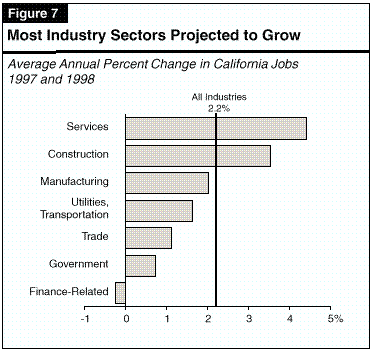
The budget forecast is generally consistent with recent projections made by other economists, although its state personal income forecast is slightly above the consensus.
| Figure 8 Governor's Budget Revenue Forecast | |||
| (Dollars in Billions) | |||
| Actual
1995-96 |
Projected | ||
| 1996-97 | 1997-98 | ||
| Revenue source | |||
| Personal income tax | $20.9 | $22.7 | $24.2 |
| Sales and use tax | 15.8 | 16.5 | 17.3 |
| Bank and corporation tax | 5.9 | 5.8 | 5.9 |
| All other | 3.8 | 3.5 | 3.2 |
| Totals | $46.3 | $48.4 | $50.7 |
| Percent change | 8.4% | 4.6% | 4.7% |
| Detail may not total due to rounding. | |||
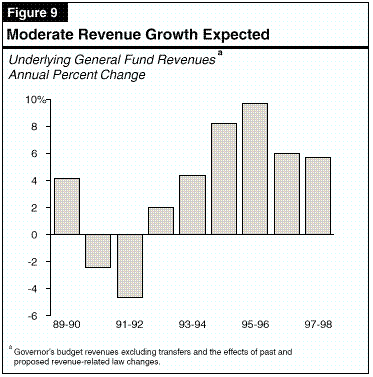
Revenue-Related Proposals. The revenue projections incorporate the Governor's proposal to reduce the bank and corporation tax rate by 5 percent in 1998 and another 5 percent in 1999, and to partially conform state law to recent federal changes involving Sub-Chapter S corporations. The revenue cost of these proposals is $93 million in 1997-98, rising to $654 million by 2000-01 when fully phased in. In addition, the projection for 1997-98 assumes implementation of the Governor's trial court funding proposal, including redirecting $290 million in court fines and penalties from the General Fund to a trial court trust fund. Also assumed is $85 million from federal adoption of a tax offset program as noted earlier.
How Is Revenue Growth Allocated? The Governor's projections are that budget-year revenue growth will be $2.3 billion (4.7 percent), or $2.4 billion absent his tax cut proposal. Figure 10 (see next page) shows how the budget proposes to allocate this revenue growth--a net of $1.9 billion for spending (most for K-12 education under Proposition 98), $0.4 billion for improving the budget reserve, and $0.1 billion for the tax cut.
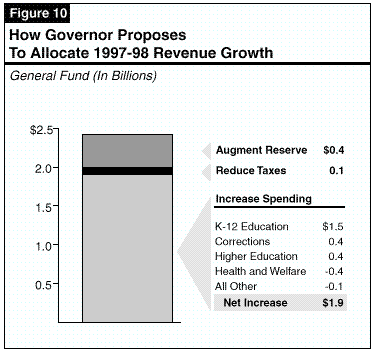
Comparison to Legislative Analyst's Office. The budget assumes slightly stronger economic growth than our November forecast. Its revenue forecast, however, is lower than ours by $266 million in 1996-97 and $399 million in 1997-98, or $665 million combined. Most of the difference is related to the budget's more conservative estimate of sales tax revenues.
| Figure 11 General Fund Spending by Major Program Area | ||||
| (Dollars in Millions) | ||||
| Actual
1995-96 |
Estimated 1996-97 |
Proposed 1997-98 | ||
| Amount | Percent Change | |||
| Education Programs | ||||
| K-12 education | $17,791 | $19,427 | $20,936 | 7.8% |
| Community Colleges | 1,600 | 1,783 | 1,932 | 8.4 |
| UC/CSUa and other | 3,931 | 4,328 | 4,562 | 5.4 |
| Health and Welfare Programs | ||||
| Medi-Cal | 6,253 | 6,908 | 6,943 | 0.5 |
| AFDCb | 2,712 | 2,229 | 1,966 | -11.8 |
| SSI/SSPc | 2,051 | 2,070 | 1,660 | -19.8 |
| Other | 3,248 | 3,685 | 3,968 | 7.7 |
| Youth and Adult Corrections | 3,946 | 3,834 | 4,257 | 11.0 |
| All Other | 3,861 | 4,179 | 4,077 | -2.4 |
| Totals | $45,393 | $48,443 | $50,301 | 3.8% |
| a University of California/California State University. | ||||
| b Aid to Families with Dependent Children. | ||||
| c Supplemental Security Income/State Supplementary Program. | ||||
| Figure 12 Major 1997-98 Budget Proposals and Assumptions | |
| (In Millions) | |
| Expenditure-Related Proposals and Assumptions | Effect on
Expenditures |
| Welfare | |
| Grant reductions state cost-of-living adjustment suspensions | |
| Aid to Families with Dependent Children | -$245 |
| Supplemental Security Income/State Supplementary Program | -196 |
| Governor's welfare reform proposal | |
| New grant structure and paternity establishment requirements | -176 |
| Employment services and county administration | 172 |
| Infant Health Protection Initiative | 22 |
| Medi-Cal | |
| New federal funds for emergency services to undocumented persons | -$216 |
| Elimination of state-only prenatal care for undocumented persons | -80 |
| K-12 Education | |
| Additional class size reduction | $457 |
| Community Colleges | |
| Welfare reform-related initiatives | $53 |
| Higher Education (CSU and UCa) | |
| "Buy out" of student fee increase | $67 |
| Other initiatives | 15 |
| Local Government | |
| Allocation of federal welfare block grant to counties for juvenile probation costs | $141 |
| Other | |
| Eliminate renters' credit | -$525 |
| Tax-Related Proposals and Assumptions |
Effect on
Revenues |
| Bank and corporation rate reduction and federal conformity | -$93 |
| Federal Internal Revenue Service tax offset program | 85 |
| aCalifornia State University and University of California. | |
Budget Makes Permanent the Temporary Welfare Grant Reductions and COLA Suspension. The Governor's budget proposes to make permanent the Aid to Families with Dependent Children (AFDC) and SSI/SSP 4.9 percent statewide grant reductions adopted in 1995-96. In addition, suspension of the COLAs would be made permanent. Under current law the grant reductions and the AFDC COLA suspension are scheduled to be restored on November 1, 1997, with the state SSP COLA to be restored on January 1, 1998. The Governor's proposal would avoid increased General Fund costs of about $441 million in the budget year.
Major Budget Impacts of Federal Welfare Reform. On August 22, 1996, the President signed into law H.R. 3734--The Personal Responsibility and Work Opportunity Reconciliation Act of 1996. The budget estimates that federal welfare reform will result in net General Fund savings of $274 million in 1996-97 and $288 million in 1997-98 due to the federal TANF block grant. (This assumes that the state enacts all of the Governor's welfare reform initiatives and TANF spending proposals.) Federal welfare reform also makes most legal noncitizens ineligible for SSI/SSP, resulting in estimated General Fund savings of $153 million in the budget year.
Governor's Proposal to Reform Welfare. The Governor proposes to fundamentally redesign the state's AFDC program, effective January 1, 1998. Figure 13 summarizes the major provisions of the Governor's welfare reform proposal. The Governor's proposal includes benefit reductions pursuant to specified time limits, changes in how grants are determined for recipients with income, work and training participation mandates, and expanded paternity establishment requirements.
| Figure 13
Governor's Proposal to Reform Welfare | ||
|
||
|
||
|
||
|
||
| ||
The Governor's welfare reform proposal involves state savings of approximately $176 million from changing the grant structure and paternity establishment. These savings are nearly offset by $172 million in costs for employment services, automation improvements, and training for county caseworkers. Thus, the net fiscal effect of these proposals is an approximate "wash."
Medi-Cal. The budget proposes General Fund expenditures of $6.9 billion for the Medi-Cal program, a 0.5 percent increase from the current year. The budget also recognizes a current-year deficiency of $429 million, about one half of which is due to the absence of a federal appropriation of funds for the state costs of emergency services to undocumented persons. The budget assumes that federal funds for this purpose will be appropriated in the 1998 federal budget, resulting in a $216 million state savings in 1997-98.
The budget assumes elimination of state-only prenatal care benefits for undocumented persons, pursuant to federal welfare reform legislation, for a General Fund savings of $80 million in 1997-98. The budget proposes to continue Medi-Cal (as well as AFDC/TANF) benefits to legal immigrants in the country prior to August 22, 1996. However, legal immigrants entering the country after that date would not be eligible for nonemergency services.
In contrast to proposals in recent years, this year's budget does not propose to eliminate optional Medi-Cal benefits, and contains relatively few new initiatives.
Infant Health and Protection Initiative. The Governor proposes an initiative designed to protect children from substance-abusing parents, through early detection and intervention services focusing on newborns and their mothers. The program includes stronger requirements for hospitals to detect signs of substance abuse or substance exposure to babies, treatment services, and home visitations. The Governor proposes $22 million from the General Fund for this program.
Figure 14 displays the major uses of these additional funds. The largest share--$629 million, or 38 percent--would provide a 2.5 percent COLA for district and county office revenue limits as well as selected categorical programs. Providing general-purpose funding for the projected 2.3 percent growth in the student population accounts for $482 million, or 29 percent, of available funds. The Governor's class size reduction proposal accounts for another $457 million, or 27 percent. The remaining $110 million, or 6 percent, is dedicated in the budget proposal for special education reform ($77 million) and various other categorical program increases.
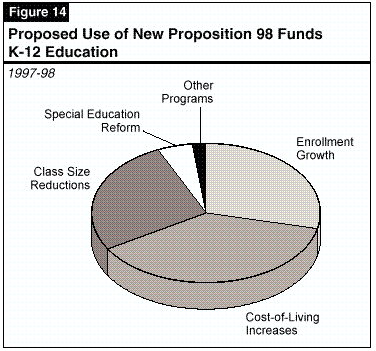
The emphasis on funding categorical program increases means that none of the new 1997-98 Proposition 98 monies would be available for locally determined priorities. The budget does not propose to use 1997-98 Proposition 98 funds to increase per-pupil local revenue limits above the statutorily required COLA. The COLA is designed to maintain the purchasing power of funding provided to schools, not afford an increased level of services. As a result, the budget would provide increases only in those targeted areas and not for needs identified by local school boards.
The Governor is also proposing a $2 billion bond for school facilities to accommodate enrollment growth and class size reduction.
Community Colleges. The budget proposes a $238 million increase in total community college funding (of which $149 million would come from the General Fund). This funding increase covers growth in enrollment, full statutory cost-of-living increases, and a variety of other initiatives. Among these are about $53 million in funds which would be allocated for purposes related to federal welfare reform. These include work-study and child care services for community college students who are welfare recipients.
University of California (UC) and California State University (CSU). The budget proposes increases to the UC and the CSU budgets totaling $194 million in 1997-98. This increase includes funding to maintain the Governor's "compact" with higher education, which includes 4 percent annual budget increases for both segments. It also includes $67 million to "buy out" the 10 percent fee increases provisionally approved by the Regents and Trustees of the two systems. Thus, student fees would be held constant for the third consecutive year. The budget also proposes $15 million, for the two systems combined, for a variety of new initiatives.
In addition, the budget proposes funding, primarily from anticipated federal funds, for six prisons as follows: (1) design and construction of one new prison, (2) land acquisition and design of two additional prisons, and (3) environmental reviews for three more prisons.
Trial Court Funding Redirection. The budget proposes to consolidate and restructure the Trial Court Funding Program. The proposal, which is nearly identical to the Governor's 1996-97 proposal, would cap the contribution counties make for support of the trial courts and make the state responsible for growth in trial court costs. The proposal also calls for increases of about $88 million in court-related fees to offset costs of the state and requests about $27 million to create 40 new trial court judgeships, enhance trial court security, and reimburse certain expenses of trial court jurors.
| Figure 15 Major New Budget Proposals Affecting Local Government 1997-98 | |
| Proposal | Local Fiscal Impact |
| Public Safety/Criminal Justice | |
| Transfer trial court funding responsibility to the state. | Savings to counties of tens of millions of dollars in 1997-98, growing substantially thereafter. |
| Increase funding for juvenile probation. | $141 million of the federal welfare block grant (Temporary Assistance for Needy Families) to be allocated to counties for probation. |
| Allocate 15 percent of federal crime bill funds for prison construction to local correctional facilities (maximum allowed by law). | $15 million to local government for jail or juvenile hall construction, with additional amounts through 1999-00. |
| Welfare | |
| Counties relieved of obligation to provide General Assistance. | Potential county savings of up to hundreds of millions of dollars annually. |
| Counties to administer new program. | Counties to receive $80 million (one-time) for training and implementation. Counties to share in future costs or savings. Unknown overall local fiscal impact. |
| Other Programs | |
| Infrastructure bank | $200 million general obligation bond issue proposed for capitalization of an infrastructure bank. |
In addition, funding for several previously enacted programs is continued in the budget year. These continuing programs include:
Employee Compensation. The Governor's budget does not provide for any general pay or benefit increases for state employees. The UC and the CSU have indicated, however, that salary increases for their employees will be provided from "compact" funds. Based on 1997-98 salaries and wages for state employees (other than higher education), we estimate that it would cost nearly $100 million per 1 percent general salary increase for these employees. About $55 million of this cost would be General Fund and about $45 million special funds.
Capital Outlay. The budget proposes nearly $1.2 billion for capital outlay other than highways and rail. The majority of spending is for higher education facilities and new state prisons.
On February 19, we will release our Analysis of the 1997-98 Budget Bill, which will contain our detailed analysis and recommendations relating to the budget proposal. The Analysis will be accompanied by our Perspectives and Issues, in which we will evaluate the Governor's economic and fiscal projections and update our own previous projections that were published in California's Fiscal Outlook: The LAO's Economic and Budget Projections for 1996-97 through 1998-99 (November 1996).
| Figure 16
Key Budget-Related Issues and Considerations Facing the Legislature | |||
|
|||
|
|||
|
|||
|
|||
|
|||
|
|||
|
|||
|
This report and others are available on the LAO's World Wide Web page at http://www.lao.ca.gov. The Legislative Analyst's Office is located at 925 L Street, Suite 1000, Sacramento, CA 95814. |